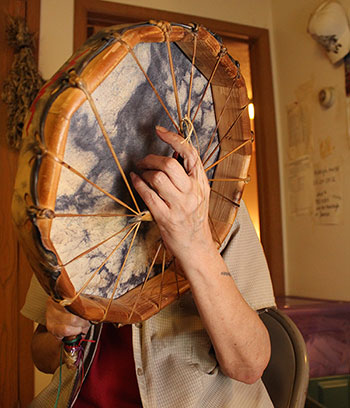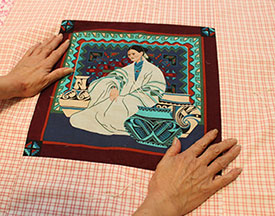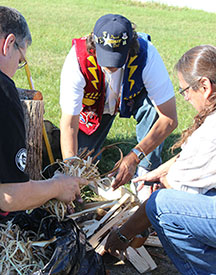
The guests have traveled 1,000 miles, yet they’re very anxious about what might take place.
They’ve come to meet with Carol Guinn, a resident of Biimaadiiziiwiin, an affordable senior housing community in White Earth, Minnesota, that’s operated by United Church Homes and located on the White Earth Reservation. The background information about Carol is intriguing and fascinating. Carol is a traditional healer for the White Earth Band of the Chippewa tribe, also known as the Ojibwe Anishinaabbe, esteemed far and wide for her work using ancient, time-honored ways to help people with various maladies. She’s also an artist, intricately involved in other aspects of preserving timeless tribal images.
She’s mystical and mysterious. Yet it’s possible she may not agree to be interviewed.
That’s because Carol will ask the Spirit for permission to cooperate, says Lonnie Dockter, community manager at Biimaadiiziiwiin. She does the Spirit’s will. Lonnie explains that his meetings with Carol always begin with a gift of tobacco, an item held sacred among the native people, and a few dollars, given to honor the Creator.
We enter Carol’s apartment. Lonnie does most of the negotiating. We offer our gifts of tobacco and money. She accepts. We ask if we can photograph her. She consents, but with a condition. We cannot take an image that shows her face. We agree. We ask if we can interview her. She says she must first consult with the Spirit. Slowly and rhythmically she taps her hand-held drum for a few minutes, chanting in her native tongue. We listen and watch in silent, rapt attention. Finally, she breaks into a smile and agrees to be interviewed. The Spirit told her, “Go for it.”
It is not an accident, she tells us, that our publication is named Spirit.
 Carol’s apartment is awash with materials she uses to make quilts for tribal drum ceremonies that are held throughout the year. She’s constantly at work creating the quilts, making two dozen every six months. Images, material and colors abound around her, cascading upon every surface. Carol is so absorbed by her work that she doesn’t notice the overall effect. Her apartment is 90 percent art studio, and 10 percent living quarters. “What’s important is that people acknowledge and recognize their Indian heritage,” said Carol. “My role is to be an interpreter, and to help people get to where they need to be.”
Carol’s apartment is awash with materials she uses to make quilts for tribal drum ceremonies that are held throughout the year. She’s constantly at work creating the quilts, making two dozen every six months. Images, material and colors abound around her, cascading upon every surface. Carol is so absorbed by her work that she doesn’t notice the overall effect. Her apartment is 90 percent art studio, and 10 percent living quarters. “What’s important is that people acknowledge and recognize their Indian heritage,” said Carol. “My role is to be an interpreter, and to help people get to where they need to be.”
Carol was born in 1947 and raised by Roman Catholic parents. She married and raised a family, but her life lacked fulfillment. In her mid-30’s she was approached by elders to be trained as a traditional healer. The training would involve years of learning the old ways and the culture, all of which was passed on to her in an oral tradition that’s been in place for countless generations. The offer was not to be treated lightly, nor meant for the faint of heart. It would be a vocation, a commitment. “I’m not a medicine woman,” she said. “Everything I do is done with love — with a very special and caring spirit.
“I’m here to help.”
 Carol’s words are evident the next day at a drum ceremony held 50 miles north of Biimaadiiziiwiin. The drum ceremony is one way the tribe seeks to unify their community, communicate their world view and perpetuate their traditions. The ceremony is attended by about 175 people, of all ages, some of whom have traveled through the night to be there. One young man drove in from Manitoba, Canada, roughly 750 miles away. He said he wouldn’t miss the drum ceremony, despite concerns that he might experience a mechanical breakdown en route. The Spirit will guide him there … and get him home.
Carol’s words are evident the next day at a drum ceremony held 50 miles north of Biimaadiiziiwiin. The drum ceremony is one way the tribe seeks to unify their community, communicate their world view and perpetuate their traditions. The ceremony is attended by about 175 people, of all ages, some of whom have traveled through the night to be there. One young man drove in from Manitoba, Canada, roughly 750 miles away. He said he wouldn’t miss the drum ceremony, despite concerns that he might experience a mechanical breakdown en route. The Spirit will guide him there … and get him home.
The drum ceremony is steeped in ritual, with every song and cadence and dance-step flush with meaning and symbolism and significance. There’s so much happening at once it would be impossible to identify every thread. “We could tell you things for days and days about what everything means,” said Terrance Burnette, Sr., the drum master. “We see a world where everything is linked together — people, places, beliefs. We want to preserve the traditions that were passed down to us from our ancestors, from long before anyone else lived here.”
The native people extol the virtues of their teachings, centering on attributes such as truth, courage, kindness, respect, humility, wisdom and, as Carol told us time and again, love.
There’s mounting interest within the tribe in returning to their traditional teachings, ones that place greater faith and value in what they’ve known and respected for hundreds of years. Where the young have high regard for their elders, where their rituals are in sync with the seasons and their sacred crops, where the language is still spoken and understood in all of its richness, and where the land upon which they live, at the headwaters of the Mississippi River, is venerated. This last item, currently under assault by a proposed oil pipeline, is a topic that induces opinions from all, right or left, young or old. It’s not about profits. It’s about preserving ancestral lands, given to the tribe by the Creator.
Carol walks through drum ceremony attendees the way a rock star would walk through an auditorium. Everyone wants to speak with Carol, to thank her for a healing she’s done, to praise her work, to touch her, to spend a moment with her. “I cannot walk through a crowd of people without this happening,” she says. “It’s just part of my world.”
For Carol Guinn, traditional healer, her engagement at the drum ceremony makes her work worthwhile. It’s not about her, it’s about her sense of community, held together by the stitches in her quilts. United Church Homes is humbled by the opportunity to share in community with the Ojibwe Anishinaabbe people.
